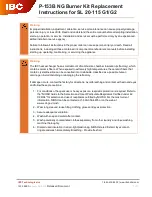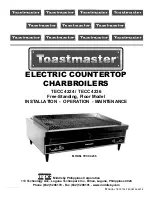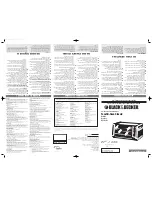
20
faces and greatly reduce capacity and effi-
ciency.
f. Use of antifreeze in any boiler will reduce
heating capacity by as much as 10-20% due
to differing heat transfer and pumping char-
acteristics. This must be taken into consid-
eration when sizing the heating system,
pump(s) and expansion tank. Consult anti-
freeze manufacturer’s literature for specific
information on reduced capacity.
g. Water content of the boiler is 2.6 gallons
(10 liters).
h. Antifreeze will raise the pH of the water in
a heating system to between 8.0 and 10.0.
This is due to the corrosion inhibitors in the
antifreeze.
FILLING BOILER WITH WATER AND
PURGING AIR FOR SYSTEMS WITH
DIAPHRAGM TYPE EXPANSION TANKS
Refer to the appropriate diagrams in Section VII,
“Near Boiler Piping,”
for more information.
1. Close all zone service valves on the supply
and return piping. Open the feed valve and fill
boiler with water. Make sure air vent is open.
Hold relief valve open until water runs air free
for five seconds to rapidly bleed air from boiler,
then let the relief valve snap shut.
2. Open the zone service valve on the supply
pipe for the first zone. Open the purge valve
on the first zone. Feed water will fill the zone,
pushing air out the purge valve. Close the purge
valve when the water runs air free. Close the
zone service valve.
3. Repeat step 2 for all remaining zones.
4. Open all service valves. Any air remaining
trapped in the return lines between the service
valves and the boiler will be pushed towards the
air vent when the boiler is placed in operation.
5. Inspect piping system. Repair any leaks im-
mediately.
FILLING BOILER WITH WATER
AND PURGING AIR
FOR SYSTEMS WITH CONVENTIONAL
CLOSED TYPE EXPANSION TANKS
Refer to the appropriate diagrams in Section VII,
“Near Boiler Piping,”
for more information.
1. Close all zone service valves on the supply
and return piping and close the expansion tank
service valve. Drain expansion tank. Open the
feed valve and fill boiler with water. Hold relief
valve open until water runs air free for five sec-
onds to rapidly bleed air from boiler, then let the
relief valve snap shut.
2. Open the zone service valve on the supply
pipe for the first zone. Open the purge valve
on the first zone. Feed water will fill the zone,
pushing air out the purge valve. Close the purge
valve when the water runs air free. Close the
zone service valve.
3. Repeat step 2 for all remaining zones.
4. Open the expansion tank service valve and
the tank vent. Fill the tank to the proper level
and close the tank vent. Remove the handle
from the expansion tank service valve so the
homeowner doesn’t accidentally close it.
5. Open all service valves. Any air remaining
trapped in the return lines between the service
valves and the boiler will be pushed towards the
expansion tank when the boiler is placed in op-
eration.
6. Inspect piping system. Repair any leaks im-
mediately.
NOTE:
DO NOT use stop leak compounds. Leaks in
threaded connections in the aluminum boiler sections must
be repaired immediately. Aluminum threads will not seal
themselves.
PLACING BOILER IN OPERATION
READ BEFORE OPERATING APPLIANCE
1. This appliance does not have a pilot. It is
equipped with an ignition device which automat-
ically lights the burner. Do NOT try to light this
burner by hand.
















































